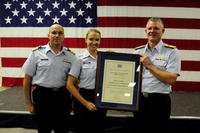The Air Force is reviving the name "Jolly Green Giant" for its newest combat search-and-rescue helicopter, the HH-60W.
It's a fitting tribute, not only to the helicopter that saved so many American and allied lives during the Vietnam War, but also to the pararescue jumpers who risked their lives so that others might live.
On Feb. 6, 1967, Airman 2nd Class Duane D. Hackney was one of those pararescuemen. While he was in the back of one of the Air Force's original Jolly Green Giants, an unarmed HH-3E, the crew got a call about a downed pilot. The pilot's Cessna O1-F Bird Dog went down near the Mu Gia Pass, deep inside North Vietnam and a key crossing point into Laos for the Ho Chi Minh Trail.
Dangerous missions were nothing new for the pararescue crews of the Vietnam War, and for Hackney in particular. He enlisted as a PJ in 1965 and flew his first rescue mission on his third day in Vietnam. On his 10th combat mission, he was seriously wounded, hit in the leg with a .30-caliber round while extracting a wounded Marine.
Read: In Vietnam-Era Throwback, New Air Force Rescue Helo Is the 'Jolly Green II'
To avoid getting grounded by doctors, he asked one of his fellow PJs to extract the bullet for him. It would not be the last time he looked certain death in the face.

During his nearly four-year tour in Vietnam, he would fly some 200 rescue missions. Hackney's helicopters were shot down five times. His astonishing record of saving lives would earn him more than 70 medals for bravery, including 28 for valor, 18 Air Medals, a Silver Star, a Purple Heart and an Airman's Medal.
The mission at Mu Gia Pass, in the face of withering enemy fire, might not have been anything new for then-Airman Hackney, who was exceptionally accustomed to putting his life on the line for those he would rescue. But for this mission, he would become the first living recipient of the Air Force Cross.
Two sorties had already been dispatched in an attempt to rescue the downed pilot, Capt. Lucius Lamar Heiskell, but turned back because of bad weather. As the sun went down that day, two HH-3s, one with Hackney aboard, went out to make one last attempt. Once Heiskell was located, the Jolly opened its doors and Hackney went out to hoist the wounded pilot to the hovering aircraft.
According to "Leave No Man Behind: The Saga of Combat Search and Rescue," the wounded pilot hugged Hackney once inside the Jolly and said, "You're beautiful."
"Hey, man," replied Hackney, "I'm not the stewardess."
Then all hell broke loose.
Ground fire erupted from the surrounding area, all directed at the two hovering helicopters. When a 37mm anti-aircraft shell hit his HH-3, Hackney immediately took off his parachute and put it on his patient, with no regard for his own safety. As he went to grab a chute for himself, another 37mm anti-aircraft round blew a fireball through the bird -- and hit the fuel line, blowing Hackney out of the aircraft.
He had barely managed to get the new chute around himself before he fell some 200 feet. Somehow, Hackney was able to pull the cord from the unstrapped chute just in time to hit the jungle canopy, where he fell another 80 feet. He finally came to a stop on a ledge.
He was severely wounded by shrapnel and covered in burns when he landed. Hackney evaded enemy troops moving in on his location and made his way to the wreckage of his helicopter. He found he was the only survivor.

The other Jolly Green Giant had to leave the area due to the heavy enemy presence. Hackney waited for another aircraft to pass over the site. He finally saw an A-1 Skyraider pass by, so he fired a flare to get its attention. Helicopters were then sent in to pick him up.
Hackney spent a total of 26 years in the Air Force and retired in 1991 as a chief master sergeant. He was the most decorated enlisted airman ever to serve. He died in 1993 of a heart attack at age 46.
-- Blake Stilwell can be reached at blake.stilwell@military.com.
Want to Learn More About Military Life?
Whether you're thinking of joining the military, looking for post-military careers or keeping up with military life and benefits, Military.com has you covered. Subscribe to Military.com to have military news, updates and resources delivered directly to your inbox.
















